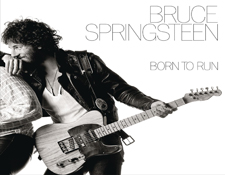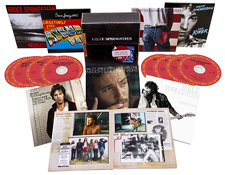It’s the time of year for saving money!
OK, so you Bruce fans out there need to get comfortable with the notion that you may have to trade in your old wings for some new wheels one more time. For this you can thank the folks behind some exciting new technology from Plangent Processes, which was integral to the new box set remasters of Bruce Springsteen’s first 10-plus years of studio recordings (also available as high-resolution downloads from HDTracks.com).
 Pulling some concise copy from the boxed set’s inside slip sheet to the new set: “Master tape-to-digital and DSP wow and flutter reduction by Jamie Howarth and John K. Chester, Plangent Processes.”
Pulling some concise copy from the boxed set’s inside slip sheet to the new set: “Master tape-to-digital and DSP wow and flutter reduction by Jamie Howarth and John K. Chester, Plangent Processes.”
Credit where credit is due.
For this first review of the new HDTracks 24-bit/96-kilohertz version and the remastered CDs in the box set, I’m going to just focus on Bruce’s landmark career-making third album, Born To Run. This is an album that is adored by most Bruce fans, often begrudgingly so by many of those who are also audiophiles.
In recent years, I’ve heard some audiophiles complain that Bruce’s albums have no dynamics and such, proclaiming he’s never made a good sounding record. Having listened to these records almost as much as my Beatles and Frank Zappa albums (and that is saying something), I had to step outside of my fanboy self when I first started trying to listen and “hear” what they were talking about back when I first read some of their gripes several years ago.
They complained there was no bass and dynamic range and such.
OK, so I kinda sorta almost get what they are talking about, but at the end of the day I’m not buying it. I think it is a matter of perspective and definition as to what comprises a “good-sounding record.” I think it is safe to say that Bruce’s records are tailor-made for radio, first and foremost. Taking his cues from Phil Spector and Brian Wilson before him, Bruce always made sure his recordings “popped” real well when playing on a 3-inch transistor radio speaker. Whether you were listening on a car stereo or a boom box, you knew immediately that a Bruce album wasn’t going to be a record with the wild dynamic palate of a group like King Crimson or Yes or Frank Zappa. That doesn’t make them any less good or less enjoyable to listen to.
That radio-ready flavor simply IS the sound of these records.
These are rock and roll records, folks. Deal with it.
I think it is unfair to write off a great album as sucking simply because it doesn’t meet the minimum daily requirements for the average audiophile. For what they are, Bruce’s albums have always had a raw, rock ‘n roll spirit that fits just right like that pair of perfect jeans on a hot summer night. You want more bass? Well, you can turn up the bass on your fancy EQ. And besides, if you play a record like Born to Run real loud, you’ll get plenty of bass in your face in proportion to the rest of the recording.
I’ll step down from that soapbox now and get back to the review.
To prepare for this review, I re-explored several versions of Born To Run including:
A) A white label promo DJ copy P-AL-33795-1A / P-BL-33795-1A
B) Stock first pressing, same stamper # as above, with the typo-corrected sticker on the back cover
C) 30th Anniversary box set CD
D) New 2014 box set CD version
E) New 2014 HDTracks 24-bit/96-kilohertz download version
For the purposes of this review I’ll just focus on a few of songs to give you some perspectives on how these new wow-and-flutter-corrected versions differ (and are hopefully improved).
Starting with the title track, the HDTracks download is the hands-down winner here.
On the new version of the song “Born To Run”:
— The drums are fuller and rounder, and very punchy.
— The recording speed seems more consistent. Moments that used to drag subtlety are now more driving all the way through (listen how it drives right after the first chorus into the second verse).
— The highs are bright but not as harsh as the CD versions (that is probably a result of compression on the CD version more than anything).
— You can hear Bruce’s strumming acoustic guitar very clearly now where as in earlier versions it was just sort of a ghost image, if you will. (Was it really there? Now you can “see” it!)
— The bells on the bridge are now clear as… well… a bell!
— The fuzz bass lines are much more distinct.
— Bruce’s vocals are much clearer overall
On “Meeting Across the River,” there is far less wavering of the piano, something that always sounded a bit off to my ear, detracting from the song’s drama. I even checked my LP pressings to see if they were off-center and they aren’t. You can hear this wavering on the 30th anniversary CD version too, making Roy Bittan’s piano sound every so slightly like it is going in and out of tune and time. It is on details like this that the Plangent Process shines.
Epic album closer “Jungleland” has never sounded quite so majestic. That is saying something, since this song was always entirely about majesty. Now there is no hesitation on the violin introduction. On the second verse you can now clearly hear the high organ countermelody. Listen at 2:50 right before the solo and you can hear Bruce’s vocal singing “Jungle-laaaaand” pretty much all the way to the end whereas it kind of breaks up on the earlier CD and on the LP.
 For me, the real moment of truth comes at around 3:50 when Clarence Clemmons’ saxophone solo kicks in along with the swirling Hammond organ, piano chording and lush orchestral strings. On the new HDTracks download that subtle wavering is gone, so you can now hear the full notes Clarence was blowing. Springsteen’s Lennon-esque guitar lines at this point are driving through out the solo section where as it often got lost in the earlier incarnations.
For me, the real moment of truth comes at around 3:50 when Clarence Clemmons’ saxophone solo kicks in along with the swirling Hammond organ, piano chording and lush orchestral strings. On the new HDTracks download that subtle wavering is gone, so you can now hear the full notes Clarence was blowing. Springsteen’s Lennon-esque guitar lines at this point are driving through out the solo section where as it often got lost in the earlier incarnations.
At 6:22 after the solo as the piano comes in, it always wavered there as Roy Bittan held out long comp’d notes that almost got a little flat-sounding at times (at least to my ear it did). This is much improved now. It is so much clearer now that you can even hear a little mistake Bittan makes at 7:35 mark — now even the warts come out a bit clearer! It’s a near perfect take nonetheless, so I can see why they went with it. Heck, at 7:55 I can hear a microphone or someone moving in the studio (after the line about the ambulance pulling away), a detail I never noticed on earlier versions, especially on vinyl where it was pretty much lost in the noise floor. It is there on the earlier CD, but it’s like I’m hearing this album for the first time now. Bruce’s wailing at the end sounds like you are there in the echo chamber with him. The pulsing at the final chord is no longer present as it fades out — that pulsing was wow and flutter!
If I have any complaint about these new remasters is that in comparison to the LP, it sounds a little brighter so the midrange may not be quite as warm to some ears. It is a different sort of sound than we’re accustomed to hearing on the LP all these years. But once you get used to it — which I did real quickly — I realized that that brightness is really more clarity present and perhaps less perceived murkiness.
So, like, wow, I’m all a-flutter about these flutter-reduced remasters now!
Can’t wait to check out some of the other albums….
Onward to Asbury Park and Nebraska!






